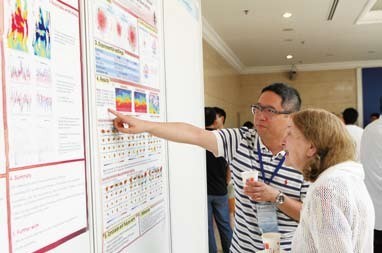Myth of infinite growth: In her keynote speech, Prof. Kalnay couples human population with existing models to better estimate the future of the earth system. Instead of unlimited growth predicted by the “Standard Neoclassical Economic Model”, human economy could collapse when a series of factors derived from human population are introduced, including depletion of natural resources and pollution sinks. “It is clear that growth cannot continue forever,” she asserts. (Photo by courtesy of CTWF secretariat.)
Teller of Future and Past
Data assimilation refers to a mathematical physics way to combine (previous) forecast with observations to give the best possible estimation for the further forecast. “For example we have a forecast from yesterday about what will happen today, and also the data from the most recent observation,” explained Prof. Kalnay: “This is like we first have the idea what will happen today, which is not accurate enough; and you combine that with the recent observations, which are also incomplete, subsequently you have the best estimation of the state of today, using the forecast as well as your observation.
“Basically it’s combining in the best possible way the forecast with the observations to get the best estimation of atmospheric state, so that you can make another forecast, combining the observations we get the best estimation of the state of atmosphere,” she continued to explain this subtle idea to the author.
It is like the models were “eating” the observations and assimilating them as an integral part of its output, said Prof. Kalnay. Further, the output forecast in return can be seen as the initial state for the next round of forecast.
“To accurately forecast the weathers of the following days, you need to input the data from today’s observation, rather than those from last year: the more recent the data, the more accurate the forecast,” advanced Prof. ZHU Jiang, head of Institute of Atmospheric Physics, CAS as well as the International Centre for Climate and Environment Sciences (ICCES), which is the organiser and host of the CTWF.
Jointly funded by CAS and TWAS, as part of the CAS- TWAS Centre of Excellence Project, ICCES is devoted to solving scientific problems in global climate and ecological environment changes, promoting further cooperation and communication with research institutes of both developed and developing countries. ICCES takes it as an important mission to provide developing countries with training programs and consulting services in the field of climate and environment sciences, and the launch of CTWF represents an effort for this sake.
Not all the observations can be used to improve weather forecasting, however, according to Prof. ZHU. “Currently only 5% data from satellite observations are used in forecasting,” he introduced: “and the other 95% observations are left out from our models.”
“Observations cannot be used by the model directly,” he explained: “because very often the data are not what the model wants. For example, the data from satellite observations are images, whereas what the model needs are changes in wind, temperature, humidity and pressure parameters, rather than images. Therefore before inputting into the model, you need to translate the black/white photos into such parameters. In the process of translation you need to couple the characters of the images with the parameters of wind, temperature, humidity and pressure from land- based observations, ideally via an optimal coupling. That is why we need data assimilation and coupled data assimilation.”
“In practice all the observations have to go through data assimilation before being input into the model,” he added.

Prof. Kalnay and Prof. Takemasa Miyoshi from the RIKEN Advanced Institute for Computational Science, Japan at the poster session of the 14th CTWF. (Photo by courtesy of CTWF secretariat.)
It takes long-term, intensive efforts by many people to develop a system of data assimilation, however. According to ZHU, such assimilation must agree with the characteristics of the data errors, and meanwhile the features of the model itself also need to be considered. Therefore it is not easy to establish a model-specific method for data assimilation.
Aside from weather forecasting and climate prediction, data assimilation can also help us understand the past climate. Meteorological observations can be traced back to the 1950s. “But at that time they occurred sporadically, producing data of low resolution. Using state-of-the-art techniques from today, we can assimilate the data from the 1950s, to better understand the situation of that decade,” Prof. ZHU introduced.
This makes data assimilation an important tool for climate change research and prediction.
“Such practice, using the latest techniques to analyse the data from the past, is called the re-analysis of data. Prof. Kalnay was the first expert to do this,” Prof. ZHU added.